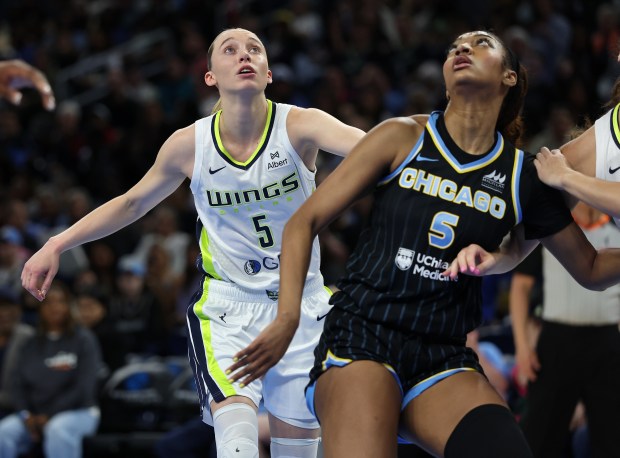Angel Reese is embracing the “mebounds” — at least as a businesswoman.
The Chicago Sky star filed a trademark application over the weekend for the term, which refers to a rebound a player secures off her own missed shot. Although the term is relatively new, the “mebound” concept has hounded Reese throughout her first two WNBA seasons.
It’s meant as an insult. It’s also mostly a myth. But Reese isn’t letting herself be treated as the victim of the joke.
“Whoever came up with the ‘mebounds’ thing, y’all ate that up,” Reese joked in a TikTok posted Saturday, the same day the trademark application was filed. “Because rebounds, mebounds, kebounds, tebounds — anything that comes off that board, it’s mine.”
Since debuting with the Sky in 2024, Reese has been criticized for sequences that feature her rebounding her own misses in repetition. This phenomenon was painfully captured during the Sky’s 2025 home opener against the New York Liberty on May 22, when Reese missed and rebounded four consecutive shots under the basket while center Jonquel Jones deflected or blocked each attempt.
The volume of Reese’s rebounds generated off her own shots has been a fixation for her critics since her rookie season — but the word “mebound” was born this year. According to Google trends, the term was coined in late May and saw a significant spike around the Sky’s first two games against the Indiana Fever.
These moments are real. And when they happen, they capture Reese at both her best and her worst — frustrating ineffectiveness at the rim paired with an unrelenting engine for winning 50-50 balls. But hyperfocusing on this specific category of Reese’s offensive rebounds distracts from the reality of her greatest strengths and weaknesses as a player.
Let’s start with the simplest question: What percentage of Reese’s rebounds are actually generated off her own misses?
Through the first 10 games this season, the “mebound” accounted for 18 of Reese’s 119 rebounds. That’s 15.1% of her total rebounding production. Even if those were removed from her tally, Reese would rank third in the league in rebounds behind Azurá Stevens (104) and Kiki Iriafen (102), both of whom have played at least one more game.
And the trend is getting better, not worse. Through the first five games, Reese averaged five rebounds off her own shots. In the last five games, that average dropped to 0.6. She hasn’t recorded a single “mebound” in the last three games.
So if Reese isn’t generating a sizable number of rebounds off this scenario, why does it dominate so many conversations about her style of play?
The “mebounds” fixation misses the heart of the problem: Reese is a poor finisher at the rim. She’s shooting 38.2% within 5 feet of the basket, a decline from her 44.5% accuracy in the same zone last season. If her efficiency matched that of other bigs in the league — between 65% and 80% — Reese could score at least five more points per game.
This is the most frustrating part of her game — and Reese is the most frustrated critic of all.
Tyler Marsh and father Donnie coach Chicago Sky using the wisdom they gained from each other
In an interview with the Tribune, she emphasized the importance of deprogramming herself from a habit of bringing the ball down before attempting shots at the rim. This tendency translates into a variety of actions — dropping the ball to her waist, using a gather dribble — that allow defenders to reposition themselves to cut off her angle to the basket.
Despite her physicality, Reese is only 6-foot-3, which often puts her at a height disadvantage against opposing centers and forwards. And once she gets trapped under their wingspan, Reese often speeds up her shot or reverts to an underhand style that is easily deflected.
Reese is working on the problem. She studies film of her finishing form on a daily basis. After practices, she spends time with position coach David Simon on simple drills to erase her instinct of tucking the ball to her stomach. She catches rebounds with her off hand held high while a personal development coach swats at her with a padded blocking guard.
“I haven’t shot the ball as well as I wanted to,” Reese told the Tribune. “My coaches and my teammates have had great patience with me. I’m trying not to be as hard on myself. I know it’ll fall at the right time and I know I’m getting the shots that I want. I’m going to be OK.”
When the shots aren’t falling, Reese often turns her attention to other aspects of her game. That was clear in Sunday’s win over the Connecticut Sun, in which Reese took only seven shots — making just two — while logging 13 rebounds, 11 assists and making all seven of her free throws for her first career triple-double.
In her new role as a “point forward,” Reese has nearly doubled her assists (3.5 per game compared with 1.9 in 2024) while taking fewer shots at the rim.
All of these improvements, however, can’t fully obscure Reese’s shooting statistics. And until she unlocks a more efficient version of herself at the rim, she’ll be stuck underperforming her offensive potential.
Still, despite this clear area for growth, the “mebound” itself remains a red herring — except to Reese’s business team, which soon could use the trademarked term to run out a new line of merchandise.



